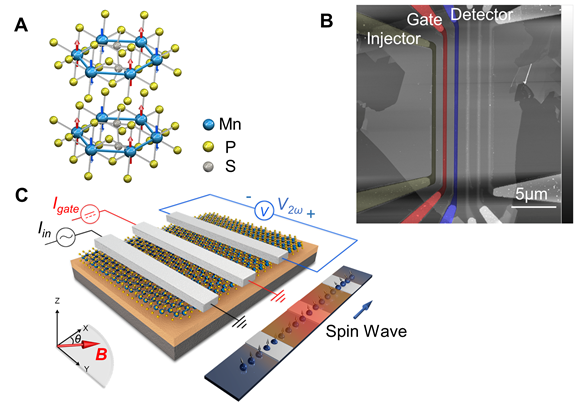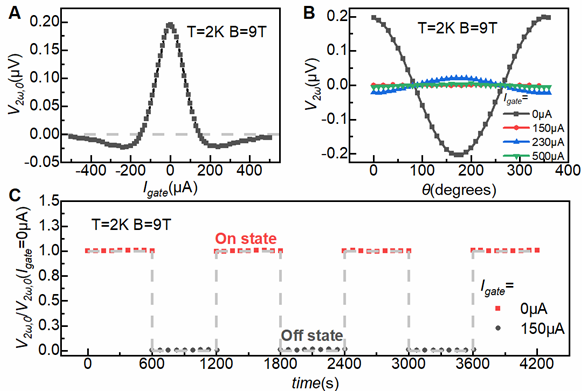Electrically Switchable van der Waals Magnon Valves
2022/02/07
Van der Waals magnets have emerged as a fertile ground for the exploration of highly tunable spin physics and spin-related technology. Two-dimensional (2D) magnons in van der Waals magnets are collective excitation of spins under strong confinement. Although considerable progress has been made in understanding 2D magnons, a crucial magnon device called the van der Waals magnon valve, in which the magnon signal can be completely and repeatedly turned on and off electrically, has yet to be realized.
Recently, a research team led by Jian-Hao Chen, who is Principle Investigator of the in-situ quantum transport group in BAQIS, demonstrated electrically switchable magnon valves based on the highly tunable two-dimensional magnons in van der Waals antiferromagnetic insulator MnPS3. By applying DC electric current through the gate electrode, the team show that the second harmonic thermal magnon (SHM) signal can be tuned from positive to negative. The guaranteed zero crossing during this tuning demonstrates a complete blocking of SHM transmission, arising from the nonlinear gate dependence of the non-equilibrium magnon density in the 2D spin channel. Using the switchable magnon valves we demonstrate a magnon-based inverter. These results illustrate the potential of van der Waals anti-ferromagnets for studying highly tunable spin-wave physics and for application in magnon-base circuitry in future information technology.
BAQIS-PKU joint postdocs Dr. Di Chen, Dr. Ming Lu, Dr. Shimin Cao as well as BAQIS engineers Dr. Yu Zhang, Dr. Shili Yan have made significant contributions to the completion of the project. The Chinese Academician, BAQIS-PKU joint researcher Dr. Xincheng Xie contributed in the theoretical understanding of the magnon valve effect, BAQIS-PKU joint researcher Dr. Jian-Hao Chen is the corresponding author of this work.
Reference: G. Chen et al., Nature Communications 12:6279 (2021)

Figure 1 | Basics of a MnPS3 magnon valve. a, Atomic model of the crystal and spin structures of anti-ferromagnetic insulator MnPS3. b, Atomic force micrograph of a MnPS3 magnon valve device. The injector, gate and detector electrodes are marked by dark green, red and blue. c, Artistic schematics of the thermal magnon generation, manipulation and detection. The upper left section shows the device structure with external circuits and direction of the external in-plane magnetic field; the lower right section shows propagation and modification of spin waves by the gate. Specifically, Iin: AC injection current; Igate: DC gate current; V2ω: the second harmonic thermal magnon inverse spin Hall signal; θ: the angle of the in-plane magnetic field with respect to the x direction.

Figure 2 | Operation of a MnPS3 magnon valve. a, V2ω,0 versus DC gate current at IgateB = 9T and temperature of 2K. b, V2ω as a function of angle θ of the external magnetic field at four different Igate values. c, Operation of the MnPS3 magnon valve with Igate toggles repeatedly between 0μA (On State) and 150μA (Off State).
 中文
中文 Email
Email QCloud
QCloud Log in
Log in
